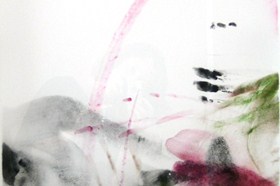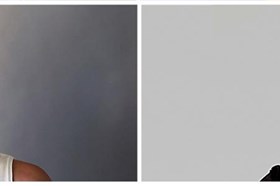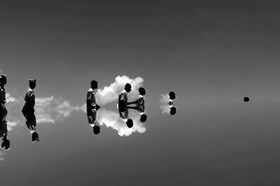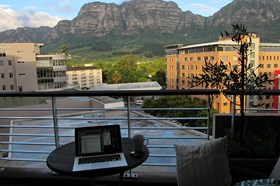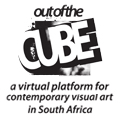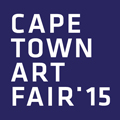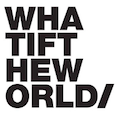cape reviews
Double Entry
Dan Halter at Whatiftheworld / Gallery
By Lloyd Pollak07 July - 14 August. 0 Comment(s)

Dan Halter
From the series 'Shifting the Goalposts',
2010.
Photographic print
125 x 85 cm.
‘Double Entry’, Dan Halter’s latest solo exhibition, examines twin themes. The privations and misery that impel Zimbabweans to quit their own country in search of a better life, the dangers they face crossing the border, and the xenophobic violence and economic exploitation that await them in the host country is one. The other is the shameful posturing of both the South African and ZANU PF governments whose empty promises have failed to alleviate the violation of human rights, poverty, hunger and desperation that prevails in Zimbabwe.
V.I.P. Border, the installation that greets us on entry, creates a powerful first impression. Ropes fashioned from red velvet yarn, exactly the same length as the border between the two countries, cordon the gallery off into narrow walkways, like those conducting weary passengers to customs and immigration at airports.
art events calendar
VIEW FULL CALENDARbuy art prints
edition of 25: R3,500.00
About Editions for ArtThrob
Outstanding prints by top South African artists. Your chance to purchase SA art at affordable prices.
FIND OUT MORE Editions for artthrobWith its suggestions of the honorific red carpet, V.I.P. Border implicitly compares the experience of privileged South Africans shuttling between Zimbabwe and South Africa, with that of a black Zimbabwean fleeing south. Although V.I.P. Border immediately inspires empathy for the refugees’ predicament, it also decisively separates the ‘them’ who are the subject of the exhibition, from the ‘us’ who are attending it. It contrasts the comfort and security of those with an inalienable right to be here, with the fear and abjection of those whose presence is illegal, and whose very lives may be at risk. Photographs of sandy, stony soccer fields in poverty-stricken townships complete the picture, and convey the sheer wretchedness and misery of Zimbabwean lives in their home and adopted countries.
At the end of the queue, a checked, plastic carry-bag stuffed with worthless Zimbabwean bank notes confronts us in illustration of how the hopes of the migrants are often dashed once they find themselves on South African soil.
The ignominy of the renewed xenophobic attacks which succeeded the orgy of self-congratulation after the World Cup, irrefutably demonstrates the pertinence of Halter’s exhibition. It may be that the artist is plumbing social and economic divisions, and attempting to convey the incommunicability of the refugee experience to the relatively privileged visitors to Whatiftheworld, but whatever the case, after an undeniably impressive start, ‘Double Entry’ slowly loses its pungency and bite.
The photographs of the border indicate that sites of suffering are empty of any evidence of the atrocities there enacted. However the monotonous veldt possesses such a desolate and forlorn character that Afro-pessimism seems inscribed in the very landscape. The lowlands surrounding the muddy, brown Limpopo are a flat, featureless wasteland of stunted trees, straggly scrub and low, misbegotten kopjes that extend without interruption to the distant horizon.
We enter the wild, the bundu, a legendary darkest Africa untouched by civilization, apart from the thin ribbons of electric fences, highways and electric lights that carve their way through the terrain leaving it otherwise unchanged. Hieratic women bearing loads on their heads solemnly proceed across the bridge, and invoke an immemorial Africa insulated from history, modernity and change. If cruelty and iniquity reign here, then that is how it was destined to be. Is that not the fate of the Dark Continent?
Although the physical appearance of the border registers forcibly upon us, we are given few insights into the horrors that take place there. ‘Double Entry’ does not convey the depth of the refugees’ misery, nor any outrage on the part of the artist. The exhibits are strangely devoid of urgency and passion, and Halter’s clinical detachment ensures that the show ceases to operate as a call to action.
The artist clearly wished to avoid the obvious, and instead of relating the heart-rending sagas of the refugees, which would have been a self-evident direction to take, he eschews emotionalism, and approaches his subject in a deliberately oblique manner, establishing an ironic counterpoint between the savage brutality of the refugee experience, and the gung-ho exuberance of the formats through which he refracts it.
The artist grew up with the Space Invaders computer game, and the invasion of space by aliens supplies the central metaphor underpinning the show, while its sound track provides an aural component. An ominous, endlessly repeated chord which decelerates or accelerates after spatters of gunfire, sets the mood of tension and jeopardy.
Halter’s video Beitbridge Space Invader handles the shooting of border crossers by the military police as a staged enactment, rather than a slice of life. Cold-blooded murder becomes a spectacle enacted within the conventions of the Space Invader game. The viewer is placed in the role of a marksman, shooting at hapless refugees moving sideways across a border bridge, and waving their arms to and fro in a stylized dance routine reminiscent of chorus lines. We are on target, for two men promptly drop down dead, whereupon Space Invader graphics flash onto the screen.
Unfortunately recent Zimbabwean history is not a musical comedy, and one questions whether Space Invaders provides an apt metaphor for a history involving such extremities of human distress. Inappropriately comic overtones also mar two videos recording the transit of refugees and their chattels from Harare to Johannesburg. Here the footage is speeded up, projecting the action into a vaudevillian context.
Halter seeks to distance intractable reality by using dissonance of mood to undermine the illusion of reality. Instead of being swept away by the drama, the spectator becomes detached, mulls over the ethical consequences of what he sees, and becomes conscious of his moral obligation to right the wrongs he witnesses. Although this is ideally what should happen, it does not. Halter’s strategies misfire, and the videos trivialize the loss of human life, and seem cold-hearted and mocking.
This is a great pity, as nothing could have been further from the artist’s mind. Halter is a sincere and well-meaning individual who has cultivated an extensive acquaintance with the refugees, and feels tremendous compassion for their situation.
One video alone - Crossing the Limpopo - espouses a cinéma vérité realism. Although it outlines the dangers border jumpers incur, its repetitiveness and jerky, hand-held footage deprive it of impact.
The Beitbridge Moonwalk video was inspired by the story of a migrant who walked backwards across the border so that his footprints would point in the wrong direction, and fool the military police. Walking backwards provides an eloquent metaphor for Zimbabwe’s regression; however the actor playing the refugee gives the action overtones of Michael Jackson’s famous moonwalk dance, sapping the video of credibility.
Finally there is Shifting the Goal Posts, a suite of eight photographs documenting an intervention whereby Halter replaced a goalpost from a soccer field in Musina, South Africa, with one from Beitbridge, Zimbabwe and vice versa. By its very nature, this conceptualist vote-of-no-confidence is directed exclusively at sophisticated gallery-going audiences capable of construing it as a telling condemnation of governmental duplicity. The intervention is so unobtrusive that it will pass completely unnoticed in the deprived, rural townships where it is located.
Such purely symbolical gestures seem to me self-indulgent in view of the gravity of the Zimbabwean situation. All too often Halter’s art did not seem an adequate response to the awful realities it addresses, and thus, despite its merits, ‘Double Entry’ often reminded me of Nero fiddling while Rome burned.


